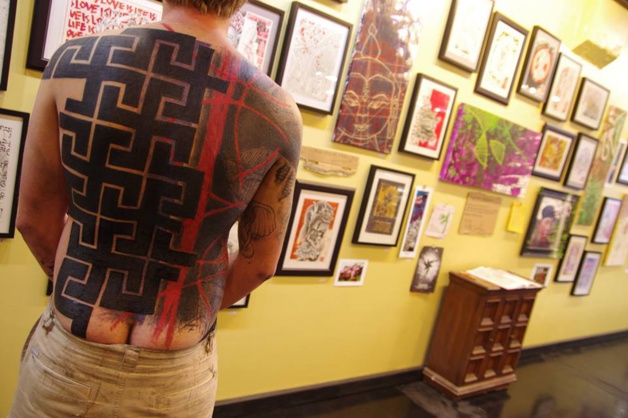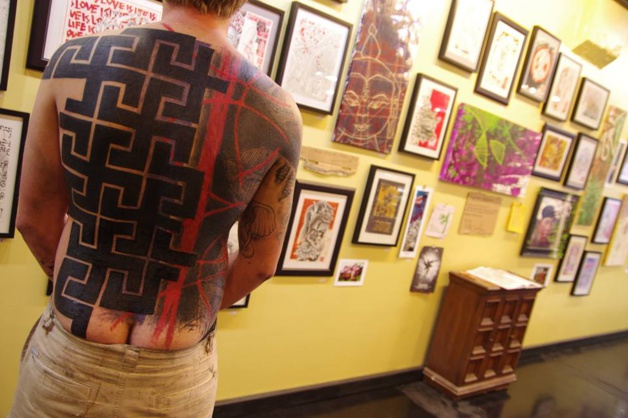
Credits Little Swastika
If you happen to go to Italy this summer, more specifically to Reggio d’Emilie, you might have the surprise of bumping into an exhibit enlightening the symbol that reminds the public of Nazism: the swastika. Paintings will be displayed, as well as sculptures and photographs. The artist who launched this idea calls himself Little Swastika. This tattooist is the owner of the German art gallery Psyland 25. Little Swastika pushes the art of tattooing to the limit and covers entire parts of the body.
According to him, “the skin is just a canvas”. The swastika can often be found in his work. Consequently, one can wonder if this artist and his customers feel any sympathy towards neo-Nazism. This is not the case: his approach is completely different. This sign, symbol of fascism and the horror of the Shoah in today’s minds, used to carry a different meaning before Hitler took it up. Several events and initiatives in the world are trying to rehabilitate the swastika.
Swastika: an ancestral and multicultural symbol
If its origin goes back to prehistory, the first traces of the swastika can be found in China and Eastern Asia, but also in Europe in countries such as Russia, Ukraine, Greece, or even in Scandinavia. It appears that its presence is most important in India. The word “swastika” comes from Sanskrit and is a synonym of happiness, well-being, and good fortune. It is a symbol of nature, love, or even a symbol of the motions of the sun in the sky. In Europe, mostly in Ukraine, archaeological digs have resulted in the discovery of the sign on numerous mosaics, jars, and sculptures.
In this part of the world, the swastika used to represent fertility. Therefore, one could wonder why in 1920 Adolf Hitler decided to use it, under the name of “hakenkreuz” in German, as a symbol of his anti-Semitic political party. The answer lies in the definition of the term “Aryan”. This word comes from Sanskrit “Arya”, which refers to the definition of a good father, faithful to his country’s god and loved by all. Hitler combined these to apply to his ideal of a tall, blond, strong man who would represent the superiority of the German nation.
Before this appropriation of the swastika by Nazis, this sign was present in the contemporary culture worldwide. It could be found for instance in ads, on beer cans, as a name for an American magazine, on covers of Rudyard Kipling’s Verse, or even in Coca-Cola’s logo.
Projects of rehabilitation of the symbol
The exhibit that will take place between July and August in Italy is not the first initiative of its kind. The pioneer of this movement is Patrick Charles Kemball, a Canadian who died in 2012. This man, also known as ManWoman, is the author of the book Gentle Swastika, Reclaiming the Innocence. ManWoman said he had a revelation in his sleep that encouraged him to proclaim the true meaning of this sign. He had over 200 tattoos of the swastika on his body.

Still in the universe of tattoos since 2013 in Scandinavian countries, tattooists committed to make free tattoos of the sign during “Learn to love swastika” day. In those countries, the thousand-year-old symbol means luck, force, energy and nature. The event had the best results in Copenhagen, with over 54 people registered last year. When a BBC journalist questioned one of the tattooists about the probability neo-Nazis might take advantage of the event, the latter answered that even if it is the case, these people will leave with a symbol of love on their body.
In the world of fashion as well, the sign appears more and more: in 2013, American designer Sinjun Wesson launched a clothing brand bearing the image of the swastika. Spiritual Punx Line collection shows the symbol on shirts, under the appearance of a pink donut for example, or followed by the mention “you are beautiful”.
All these attempts to rehabilitate the swastika lead to numerous debates: can we restore this sign within society seventy years after the Shoah, a genocide scarred by the famous symbol? Some will say no, as others will raise their voice to rehabilitate the sign. The latter is the view of a Hindu group living in Europe who opposed the German bill in 2007 aiming to forbid the swastika on the continent.
Maybe Little Swastika will bring answers to this polemic topic, a topic that moves an entire part of the artistic world on a global level.





























